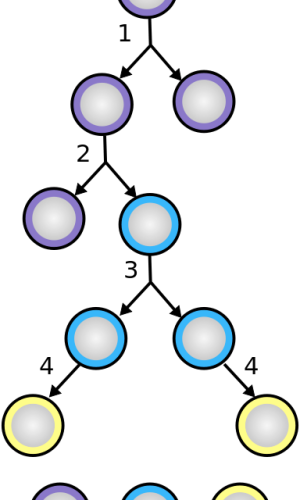Stem Cell Therapy for Dogs
THE FUTURE FOR STEM CELL THERAPY IN DOGS IS NOW
Stem Cell Therapy for dogs (SCT) is the wave of the future. There is so much more to learn but the application shows promise in helping animals to heal and live more positive, high quality lives without chronic pain. Stem Cell Therapy for dogs is in its infancy but a bright future awaits it. All successful medical technologies take time and money to bring to fruition. Clinical trials for each new application takes a long time.
Stem cells are cells at the beginning of life. The cell type has not been imprinted on them yet. They are a like a young toddler discovering a beautiful rainbow in the sky for the first time–so so new! The colored diagram to the right demonstrates this. Number 1 is the stem cell. Over time it will morph into cell types 2, 3 and 4. This means that they can be injected into any tissue type and will morph into that particular cell line. Injecting them into bone means they turn into osteoblasts and osteocytes. Injecting them into the liver would transform them into hepatocytes. This ability to morph into whatever tissue type it is in proximity with is what makes the future of stem cell therapy for dogs so bright.
CURRENT AND FUTURE USES OF STEM CELLS
The most common use of stem cell therapy for dogs are those suffering from osteoarthritis. This usually involves the hip joint (coxofemoral) but may also be used for elbow injuries. Selective use of stem cells acts as a healing and anti-inflammatory shot to the dog. Stem cells are also being used in soft tissue damage such as to the Achilles tendon in the hindquarter.
Future uses of stem cell therapy for dogs are exciting! They eventually will be used to treat many derivations of auto-immune diseases, irritable bowel syndrome, stomatitis (mouth infection-FIV) in cats plus renal and liver disease. Applying these cells to the affected body parts makes them new and young again! The downside is that stem cell therapy for dogs is not a cure but a bridge to a better and healthy life for your pet. Injections may have to be given at least several times a year. Each patient is different but injections must eventually be repeated. One of the companies that has put years of research into Stem Cell Therapy is VetStem®, a California based company.
PROSPECTIVE CANDIDATES AND ALTERNATIVES
Candidates for Stem Cell Therapy for dogs can be of any age. Most are upper middle aged dogs because that is when the pain of joint inflammation usually occurs. There are other therapies to treat osteoarthritis in the hip joint: NSAID’s, total hip replacement, ultrasound therapy amongst others. Corticosteroids help control inflammation but long term use of these drugs will lead to immunosuppression and iatrogenic (oral prednisone induced) Cushing’s Syndrome. The only requirement is that the animal is biochemically healthy to undergo the harvesting of stem cells. This is done under a general anesthetic so your veterinarian will run a CBC and Chemistry Profile before the procedure is done.
Stem Cell Therapy for dogs does not come cheap. Other forms of medical care may be acceptable and cheaper in the long run to maintain a dog’s quality of life. Expect to lay out about $2500. If you have pet insurance check with them to see how much of that they will cover.
THE PROCEDURE
Once blood work is finalized stem cells are harvested from adipose (fat) tissue. It contains the highest concentration of cells compared to other tissues. This fat is usually taken from the omentum; which is known as abdominal fat. The fat is shipped to the company in California on a monday or a tuesday where it is processed, centrifuged and reformulated into a form that can be injected back into the dog by thursday or friday. A quick turnaround indeed. The procedure can be further enhanced by culturing those specific cells so that the cells injected back into the dog are more uniform or “homogenized” as the business calls it.
Once the stem cell mixture is received back at the veterinary clinic the dog is administered a light sedative such as Telazol® and the stem cell mixture is injected right next to the problem site. Guided needle ultrasounds will insure that the stem cells are juxtaposed right next to the damaged bone or cartilage.
RESULTS AND DRUG INTERACTIONS
Once the stem cells have been introduced back into the body the time it takes for any benefit to take hold varies from about a couple of days to several weeks. People are ecstatic seeing their pet move around again! Most people realize that the dog will require numerous injections over time. So that adipose tissue does not have to be collected over and over again, there is a “bank” of the dogs tissues stored at the processing lab. This can be re-cultured, homogenized and sent to the veterinarian for injection back into the animal.
There can be complications if certain drugs are combined with stem cell therapy. On the other hand, there are drugs that are safe to use concurrent with SCT. Clients want to stay away from any corticosteroid. Depending on the version given, it needs to be totally eliminated from their system and none taken after SCT. Corticosteroids are immunosuppressant drugs and can interfere with stem cell development. NSAID’S such as Rimadyl® plus Glucosamine/Chondroitin/MSM supplements can also be taken concurrently with SCT.


